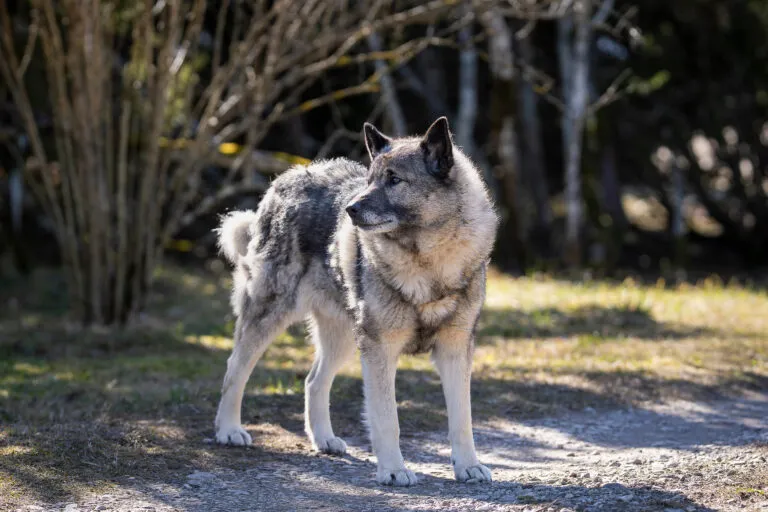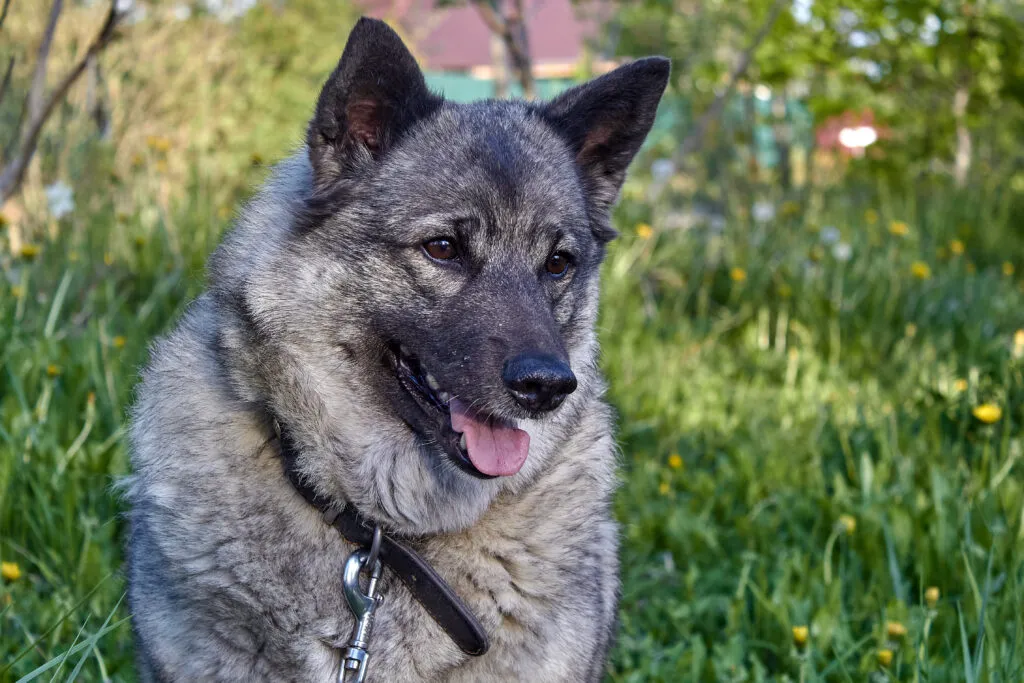Medium Size Poodle
There are two distinct breeds under the name "Norwegian Elkhound": the grey and the black Norwegian Elkhound. Here we introduce you to the Grey Norwegian Elkhound.

© Kaja / stock.adobe.com
The Grey Norwegian Elkhound’s coat, a blend of grey, black and white, reflects its northern heritage
The Grey Norwegian Elkhound boasts a very rustic appearance – similar to what one might imagine the first domesticated dogs in Western Europe looked like. Its weather-resistant fur in typical shades of grey, white and black hints at the Nordic origins of this Elkhound. However, it can also lead some to mistake it for a Husky mix at first glance.
With a maximum height of 52cm at the shoulder and a compact build weighing around 24kg, the Norwegian Elkhound is a medium-sized breed, larger than the black Elkhound. It sports pointed ears and ideally carries its tail lightly curled over its back.
The roots of this Norwegian national dog run deep: findings from the Stone Age indicate a very similar canine. Some cynologists believe that the current appearance of the breed closely resembles the first domesticated dogs in Western Europe.
In Scandinavia, Norwegian Elkhounds were primarily used for hunting elk and also bears – hence their name. The breed was mainly bred in Sweden for a long time, known as “Grey Dog”. But since 1981, Norway has taken patronage, and the breed received its current name, with the “Grey Dog” formally removed as a breed.
There are three Elkhounds in total: besides the Grey Norwegian Elkhound, there are the Black Norwegian Elkhound and the Swedish Jämthund. The grey Norwegian Elkhound is the most common: although rare outside Scandinavia, it is very popular in its homeland and is considered the national dog there.
 © Максим Туманин / stock.adobe.com
© Максим Туманин / stock.adobe.com
Norwegian Elkhounds are intelligent companions with a strong mind. Therefore, if you are looking for a dog that readily submits, this proud dog might not be the right choice. The breed is considered courageous, intelligent and friendly.
Elkhounds often like to bark – make sure to channel this tendency from a young age. Many Elkhounds make excellent guard dogs as they alert you to strangers – but being friendly, they might soon be getting cuddles from the visitor. In serious situations, these loyal dogs are always ready to protect their loved ones.
The Norwegian Elkhound can be a great family dog – provided it gets plenty of fresh air and exercise. It gets along well with children, showcasing its playful side when interacting with them.
Although this Norwegian dog does not have a submissive nature, it is considered easy to train. One advantage is that this friendly and social dog does not show dominance or aggressive tendencies.
It’s important to ensure enough activity, as bored Norwegian Elkhounds will find their own entertainment – often not to the delight of their owners. From a young age, work on good recall as a hunting dog. Also, keep an eye on its tendency to bark frequently during training.
Attending a puppy playgroup followed by dog training classes can support both you and your dog in learning together and strengthen its social skills in interacting with other dogs.
These Norwegian hunters are known to be robust and not prone to genetically inherited diseases. There is a slight predisposition to the eye disease Progressive Retinal Atrophy (PRA) and hip dysplasia – discuss this with prospective breeders, who will be happy to inform you about the health precautions concerning their breeding animals.
Keep your dog’s joints healthy with exercise and a balanced diet. Ensure that your dog has a cool spot available in the summer – while the breed tolerates cold well due to its origin, it is sensitive to heat. These natural dogs can reach an age of up to 16 years – some even older.
Like any dog, the Norwegian Elkhound needs a balanced diet with a high meat content. Ensure that meat is the first ingredient listed in your chosen food – regardless of whether you decide on wet or dry food. Grey Norwegian Elkhounds tend to gain weight easily, so keep an eye on the daily ration, including treats.
Manufacturer guidelines are only rough estimates, as metabolism and exercise change your dog’s energy needs. Regularly monitor your companion’s weight to adjust feedings if it gains or loses weight. When rewarding, use high-quality snacks without sugar and grain. Freeze-dried meat pieces are a good choice, while tough chew items satisfy its chewing needs. Always ensure your dog has enough fresh water available.
This dog’s fur consists of longer top coat and dense undercoat. It is very weatherproof and easy to brush. However, the Norwegian Elkhound sheds quite a bit, especially during its biannual moult. Brush it daily during this time to manage the hair in your home and remove dead fur.
You may need to trim nails regularly, particularly in older dogs or those that mostly walk on soft forest ground. This prevents injuries from snagged nails. If unsure, get trimming tips from your vet during check-ups – then use a special nail clipper for regular pedicures.
During brushing, check ears for dirt and clean as needed with a special ear cleaner. With daily teeth brushing using a dog toothbrush and pet-safe toothpaste, you can effectively prevent tartar and its consequences. Introduce oral hygiene to puppies early on to get them used to the routine.
The Grey Norwegian Elkhound is still a good choice for hunters, but can also be a happy family dog with plenty of outdoor time. It’s not suited to city life, preferring to romp in nature. A fenced garden would be an ideal addition to its home. This dog from the expanses of Norway doesn’t belong in a small flat – provide it with enough space.
You should have previous dog experience because, although the Elkhound is clever and eager to learn, it will not follow orders that seem pointless to it. The right mix of knowledge and sensitivity is needed. It can get along with cats, but ideally should be introduced to them as potential cohabitants from an early age.
Like any other pet, keeping this dog requires a significant time commitment: are you ready to spend several hours outside with your companion daily, no matter the weather? Also, consider the costs beforehand: besides purchase price and possibly initial equipment, regular expenses for vet visits, quality food, and insurance, should be factored in.
Those looking for a Norwegian Elkhound outside Scandinavia should be patient. In Germany, for example, there have been many years when not a single dog of this breed was born. It makes sense to contact clubs for Nordic dogs, which can help with connecting overseas. In the northern parts, naturally, there are more dogs – around 2,000 puppies are born annually in Scandinavia.
The chances of finding an adult Norwegian Elkhound in shelters outside Scandinavia are incredibly low. Therefore, even if you prefer to give an older dog a new home, reaching out to Nordic dog clubs in your country is advisable. Mixed breeds from shelters might also welcome living with you.
We wish you much delight with your charming companion from the High North!
Fans of the Bearded Collie agree that those who aren't familiar with this dog breed simply have to get acquainted with it. And those who have experienced how a Bearded Collie bolts across meadows with its flowing fur, how it rolls around full of energy and joy and how it attentively and observantly takes into account its owners wishes become simply addicted to this original dog breed and its unique charm.
The Goldendoodle isn't a breed, but a pairing between Golden Retrievers and Medium or Standard Poodles. Marketed as a low-maintenance dog for allergy sufferers, this hybrid is enjoying increasing popularity amongst dog lovers, similar to the Labradoodle.